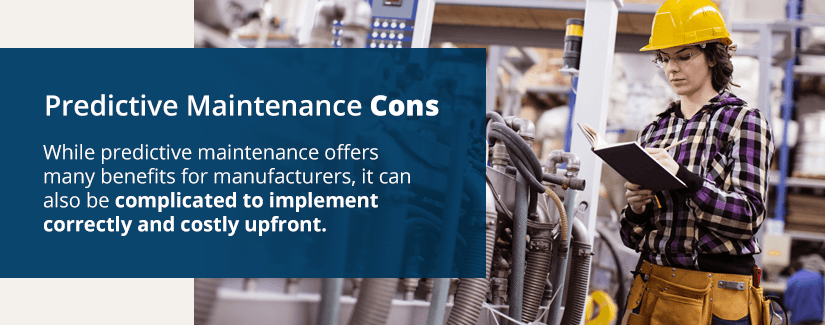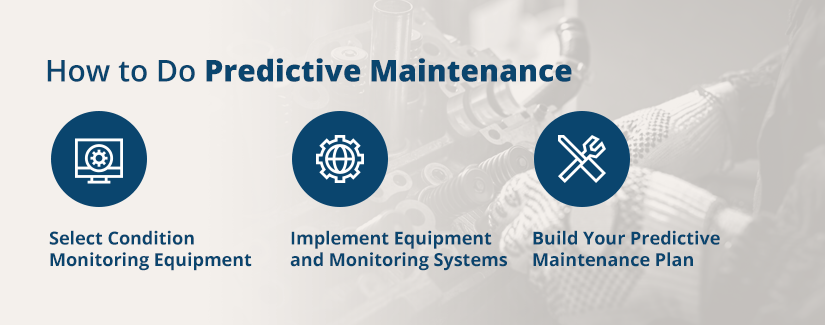Predictive Maintenance Pros and Cons

To increase productivity and reduce downtime, manufacturers must keep their equipment in top functioning condition — this requires an effective maintenance plan to ensure equipment is operating properly and to avoid a costly breakdown. Many companies turn to preventative maintenance and regularly inspect and tune-up their equipment according to a set schedule. However, this kind of periodic maintenance can also be wasteful, spending unnecessary time and manpower tending to machines when they do not need maintenance.
By choosing predictive maintenance instead, manufacturers can improve the efficiency of their equipment maintenance by only performing maintenance when it is truly necessary. Using technology to monitor the actual condition of equipment, predictive maintenance can offer more control over the equipment maintenance schedule and more cost-effective maintenance that leads to a longer equipment lifespan and more uptime. However, implementing the technology necessary for effective predictive maintenance can be a costly investment up-front. This article will outline the advantages and disadvantages of predictive maintenance so you can create the best maintenance plan for your equipment.
What Is Predictive Maintenance?
Predictive maintenance relies on predictive analytics to determine when maintenance is necessary and to pinpoint what maintenance needs to be performed. Predictive maintenance works by continually monitoring equipment data through technology to detect any patterns indicating that equipment failure is likely to occur. Maintenance can then be performed to address the specific problem and prevent the machine from breaking down.

Because predictive maintenance is only performed when equipment failure is imminent, it is more cost-effective than other common forms of maintenance like preventative or reactive. However, more than 55 percent of facilities in the U.S. still rely on reactive maintenance — also known as breakdown maintenance — and run their machines until they fail before performing repairs. This often leads to more costly repairs, greater downtime, unpredictable maintenance intervals and shorter equipment lifespan.
Another 31 percent of facilities use preventative maintenance and perform inspections, cleaning and tune-ups at regular intervals whether or not the equipment needs it. Preventative maintenance creates a predictable maintenance schedule, making it easy to plan for maintenance-related downtime, and is also better for the longevity of equipment. However, preventative maintenance can still lead to wasted resources and unnecessary downtime when maintenance is performed on machines that are already operating properly.
Just 12 percent of facilities in the U.S. use predictive maintenance, but it is increasing in popularity as manufacturers recognize the potential for more efficient and cost-effective maintenance. New technology allows companies to monitor various aspects of equipment operation — such as vibration and oil quality — so that equipment maintenance can be performed only when it is completely necessary.
What Are the Pros and Cons of Predictive Maintenance?
Predictive maintenance can reduce downtime and improve equipment life cycle, however, implementing a predictive maintenance plan can be expensive up front. Predictive maintenance also requires specialized skills for interpreting data from monitoring equipment to determine what maintenance needs to be performed. Depending on the needs and capabilities of a facility, predictive maintenance offers various pros and cons.
Predictive Maintenance Pros

When implemented properly, predictive maintenance programs can greatly reduce maintenance costs, decrease downtime and increase asset life cycle for manufacturers. Here are a few of the main benefits of predictive maintenance in manufacturing:
1. Reduces Spending
Predictive maintenance is a cost-effective maintenance solution because maintenance is only performed when it is required, eliminating unnecessary maintenance costs associated with preventative maintenance. Because predictive maintenance addresses problems before total equipment failure occurs, the costs of predictive maintenance tasks are often lower than reactive maintenance expenses.
This reduces long-term maintenance spending, as well as reducing time spent performing maintenance tasks. This can also reduce overtime hours and associated labor costs. Predictive maintenance can also increase the lifespan of equipment, which reduces expenses associated with purchasing new machinery.
According to a survey of 1,500 facilities, the average plant allocates about 16 percent of their maintenance budget to predictive maintenance, however about one-third of plants invest just ten percent or less. When implemented successfully, predictive maintenance can account for a small portion of a facility’s maintenance expenses and can greatly pay off in the long run with reduced repair costs and increased equipment longevity.
2. Decreases Downtime
Downtime caused by equipment failure can be long and costly. When machinery runs until it breaks down, the necessary repairs are often more expensive and extensive than if small repairs and tune-ups are made before equipment failure. Repairing or replacing essential equipment after a failure can lead to excessive downtime, which results in more overtime hours to make up for the loss in productivity.
With predictive maintenance, costly downtime from equipment failure can be avoided by performing maintenance tasks before a breakdown. Downtime only occurs before equipment failure is imminent to maximize equipment productivity and facility uptime.
Predictive maintenance also allows companies to clearly identify the maintenance that needs to be performed, so no unnecessary repairs or tune-ups happen. When technicians know exactly what repairs need to be made, they can order only the necessary parts and can perform maintenance tasks more efficiently.
Predictive maintenance also reduces downtime because the condition of equipment is constantly monitored while the equipment is running and production is in full swing. Instead of preventative maintenance that requires machines to be shut down to perform inspections, predictive maintenance constantly receives data on critical operations of machinery so periodic inspections are not necessary. Predictive maintenance can minimize disruptions to workflow to boost productivity and profits.
3. Protects Assets
Equipment is often a company’s greatest asset — but by running machinery until it breaks, valuable assets are put at risk. Through predictive maintenance, manufacturers can protect their equipment from failure and constantly monitor the condition of vital assets. With full visibility of the condition of machinery, companies can create the best maintenance plan to keep their equipment in peak operating condition.
4. Increases Life Cycle
When equipment is carefully maintained through predictive maintenance, it can run longer before it needs to be replaced. This increased life cycle of equipment can greatly lower long-term equipment costs. Replacing equipment also requires significant downtime, so by increasing the lifespan of equipment, companies can also reduce downtime and its associated expenses.
5. Improves Product Quality
For manufacturers, predictive maintenance can also improve the overall quality of the final product. When machines are not operating properly, this can lead to defects or inconsistencies in the final product. Continuous monitoring through predictive maintenance allows manufacturers to ensure their equipment is running smoothly and producing high-quality and consistent products. In a survey of 1,500 plants, 77 percent of plants said that improved product quality was a primary driver for adopting a predictive maintenance plan.
Predictive Maintenance Cons

While predictive maintenance offers many benefits for manufacturers, it can also be complicated to implement correctly and costly upfront. Here are a few of the challenges of predictive maintenance:
1. Requires Monitoring Equipment
To perform predictive maintenance, companies must implement condition monitoring equipment that continuously collects data from machinery and stores it for technicians to review. This equipment can take a few different forms depending on the type of machine and what its critical operations are — such as thermal imaging equipment, vibration sensors or sonic equipment. Depending on the required condition monitoring equipment, implementing a preventative maintenance system can be expensive up front.
However, as technology advances, condition monitoring equipment becomes both more advanced and more affordable. New technology allows data to be collected and stored more cost-effectively, making it possible for more manufacturers to adopt predictive maintenance strategies.
2. Requires Skillful Data Interpretation
After a company implements predictive maintenance equipment, they must also have skilled staff members who can interpret the data collected from equipment. Technicians must be able to analyze critical operations data to determine when equipment failure is imminent or maintenance is necessary. Effective interpretation of equipment data requires knowledge of both the equipment itself and of the monitoring technology.
Manufacturers may need to provide specialized training or hire new staff members for predictive maintenance to be effective. This can further increase the cost of implementing a predictive maintenance system but can pay off in the long run through the long-term benefits of predictive maintenance.
Should I Be Using Predictive Maintenance?
Predictive maintenance can provide significant benefits to productivity and profitability, but may not be right for every manufacturer. Here are a few things to consider when determining if predictive maintenance will be effective for your manufacturing company:
- Equipment monitoring needs: The most vital consideration for implementing predictive maintenance is determining if your equipment is compatible with condition monitoring equipment. For predictive maintenance to be effective, there must be technologies available that can monitor the critical operations of your machinery to accurately predict failures. If the equipment in your facility is too old or does not have a critical operation function, predictive maintenance may not be possible.
- Company scale: If your company must run and maintain a large number of machines, predictive maintenance can greatly reduce the costs of inspecting and maintaining every piece of equipment. For larger manufacturers, investment in predictive maintenance quickly pays off.
- Budget: The high upfront cost of condition monitoring equipment and staff training can be restrictive for some companies hoping to implement a predictive maintenance solution. However, if your company can foot the upfront cost, predictive maintenance can provide long-term savings and increased profitability.
With modern advancements in technology, most machinery and equipment now contains electronic controls that are compatible with condition monitoring equipment. For many companies, implementing predictive maintenance may be as simple as tapping into the data your equipment is already collecting and leveraging it to create a more streamlined and cost-effective maintenance plan.
How to Do Predictive Maintenance

To implement a predictive maintenance system, companies must determine what data they need to collect and how it will be translated into a maintenance plan. Here are some steps a company should take to perform predictive maintenance:
1. Select Condition Monitoring Equipment
Depending on the kind of critical operations that need to be monitored, different condition monitoring equipment must be used. Here are a few condition monitoring techniques that can be used for predictive maintenance:
- Vibration analysis: Vibration sensors can be used with heavy equipment to detect failure patterns in equipment functioning. As machines age, their internal components like pumps and motors will wear out and vibrate differently. Conditioning monitoring sensors can identify these changes in vibration and help determine when parts need to be replaced.
- Oil analysis: For oil-fired machines, the number of particles in the oil can be analyzed to determine the wear on equipment components. Oil with a lot of metal particles signifies greater wear and can be used to predict equipment failure.
- Thermal imaging: When machines are in use, high amounts of friction can be created between moving parts. Over time, friction causes wear and tear that can lead to equipment failure. Thermal imaging can be used to identify hot spots on equipment where too much friction is being produced so technicians can apply lubrication or repair parts to prevent costly equipment breakdown.
- Sonic and ultrasonic analysis: Sonic equipment can be used to identify and prevent potential leaks by detecting cracks in welds or failing welds before they are visible. This allows technicians to repair welds before they break and cause downtime.
Equipment monitoring sensors can be used to collect data on a variety of operational factors like temperature, vibration and friction. The right condition monitoring equipment will vary based on the type of equipment your facility uses and should be able to detect failure warning signals early enough to perform maintenance.
2. Implement Monitoring Equipment and Data Monitoring Systems
When implementing the monitoring equipment, companies may choose to start with a smaller pilot program to test out their predictive maintenance strategy. For larger manufacturers, selecting a subset of equipment to begin implementing monitoring equipment provides a chance to determine if predictive maintenance will be cost-effective on a larger scale.
To implement a predictive maintenance system, the appropriate condition monitoring equipment should be installed on each piece of equipment. These sensors should be connected to a single data monitoring and storage system where technicians can see real-time and continuous data from all machinery. By analyzing historical patterns and current patterns in equipment operation, the system can identify signs of imminent equipment failure and alert technicians to any anomalies.
3. Build Your Predictive Maintenance Plan
The last step to effective predictive maintenance is to build a plan for analyzing collected data and performing the appropriate maintenance tasks. Skilled technicians should be able to recognize which patterns and data signify a problem with equipment functioning and determine the right course of action. When developing a plan for predictive maintenance, companies can set thresholds for readings from condition monitoring equipment so they can effectively identify and prevent equipment failure.
Effective Equipment Maintenance From Global Electronic Services

Predictive maintenance can be an efficient and cost-effective maintenance solution to keep your company operating in peak productivity. By actively monitoring the condition of assets, companies can avoid costly equipment breakdowns to increase their productivity and boost their profitability in the long run.
At Global Electronic Services, we offer professional industrial electronics repair services to keep your equipment running smoothly and cost-effectively. Contact us today for more information or to request a quote for industrial electronics repair.
